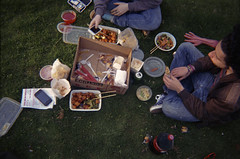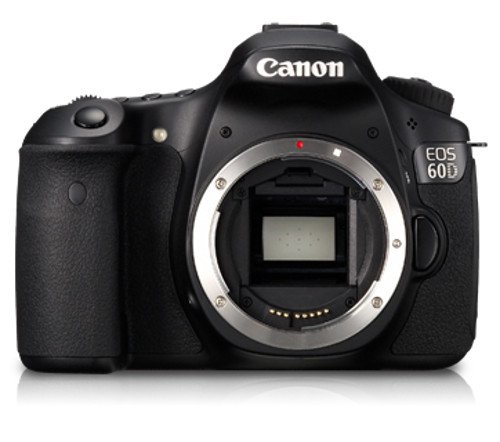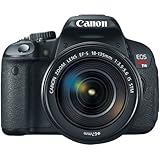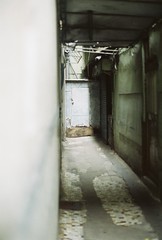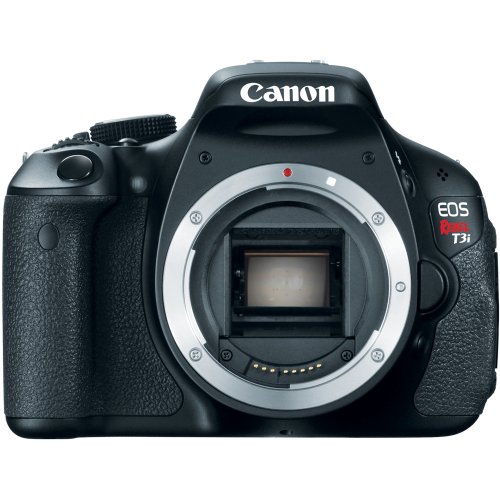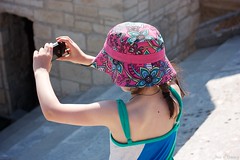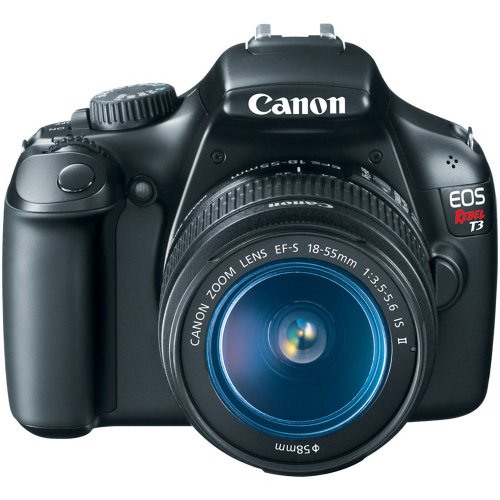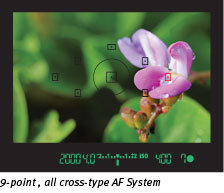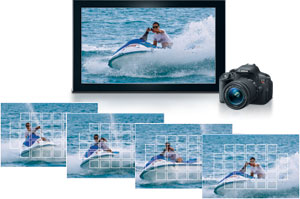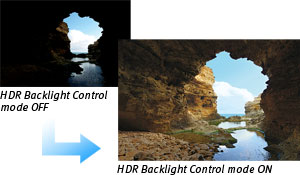Renew Your Creative Soul
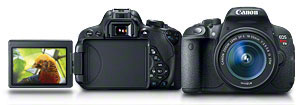
Photo enthusiasts rejoice! The new flagship of the spectacular Rebel Line, the Eos Rebel T5i, is here to renew your artistic side with amazing imaging features and full-featured functionality. Users will be impressed at how uncomplicated and intuitive it is to generate amazing photos with ease. The anticipated image potential and execution starts with an 18.0 Megapixel Cmos (Aps-C) sensor and Canon's superb Digic 5 Image Processor. Combined with an total Iso range of 100–12800 (expandable to 25600 in H mode), the Eos Rebel T5i boasts crisp, detailed images, even in low-light situations. A continuous shooting speed of up to 5.0 fps allows for fast activity capture. 9 cross-type Af focus points help ensure crisp focus throughout the frame, and the Hybrid Cmos Af theory enables speedy and exact autofocus when shooting in Live View mode. In addition, the camera is compatible with Canon Stm lenses for smooth, quiet Af performance. And the execution doesn't stop with photos. Eos Full Hd Movie mode with Movie Servo Af makes shooting high potential movies easy, and the great Vari-angle Touch Screen 3.0-inch Clear View Lcd monitor Ii makes composing fun. Seven Creative Filters, now viewable in real time, puts mixture operate directly in your hands and is just one of the many features of the Eos Rebel T5i that is sure to renew your creative soul.
Amazing Capture and Processing Power.
18.0 Megapixel Cmos (Aps-C) sensor
The Eos Rebel T5i features Canon's amazing 18.0 Megapixel Cmos (Complementary Metal Oxide Semiconductor) sensor. Exquisite for enlargements or for cropping detailed portions of the composition, the camera's sensor captures images with exceptional clarity and tonal range. This first-class sensor features many of the same technologies used by professional Canon cameras to maximize each pixel's light-gathering efficiency and has center pixels that aid in the Eos Rebel T5i's exact Af performance. This Aps-C size sensor creates an productive 1.6x field of view (compared to 35mm format).
14-bit A/D Conversion
With 14-bit analog-to-digital conversion, the Eos Rebel T5i captures and records images with marvelous gradations and detail in subtle tones and colors, resulting in more realistic and detailed images. By recording up to 16,384 colors per channel, the Eos Rebel T5i ensures that the fine detail found in subjects like foliage, sky and water are preserved and recorded with a large level of accuracy, ensuring beautiful results.
Iso 100–12800 and expandable to 25600 in H mode
Thanks to its Digic 5 Image Processor, the Eos Rebel T5i features an vast Iso range of Iso 100–12800 (expandable to 25600 in H mode) that makes shooting inherent in situations previously unthinkable without flash. The Eos Rebel T5i, with the Digic 5 Image Processor's marvelous noise-reduction technology, performs brilliantly in low-light shooting. Used with one of Canon's Ef or Ef-S lenses with visual Image Stabilizer, the Eos Rebel T5i can report beautiful images even when light sources are scarce.
Digic 5 Image Processor
The Eos Rebel T5i's Digic 5 Image Processor works with the camera's Cmos sensor to deliver images with anticipated detail in more situations, without the need for synthetic light sources. With the power of the Digic 5 Image Processor, the Eos Rebel T5i can perform higher Iso sensitivity, can shoot up to 5.0 fps continuously and can even perform advanced functions like Hdr Backlight Control, art filters, lens correction and much more. The camera's great imaging core supercharges every facet of still and spirited image capture.
The speedy Rebel!
High-speed continuous shooting
The Eos Rebel T5i can shoot up to 5.0 frames per second, continuously. Thanks to the enhanced shutter mechanism, mirror drive and camera sensor, the Eos Rebel T5i is ready for action; whether capturing that Exquisite expression, the game's winning goal, or the bride walking down the aisle, the Eos Rebel T5i delivers the speed and execution to certify results.
Enhanced Af Systems Tailored for Exquisite Stills and Video.
Exceptional autofocus execution and Hybrid Cmos Af
The Eos Rebel T5i is equipped with Af features that ensure speedy, exact and continuous Af every time. When shooting through the viewfinder, the Eos Rebel T5i has advanced autofocus with a 9-point, all cross-type Af theory (including a high-precision dual-cross f/2.8 center point) for exact focus whether the camera is oriented in portrait or scenery position. An Ai Servo Af theory achieves and maintains consistent focus with an exceptional degree of reliability.
The Eos Rebel T5i also features Canon's amazing Hybrid Cmos Af System, Exquisite for shooting photos and video in Live View. This theory combines two inevitable Af technologies, phase and inequity detection Af, for speedier and more exact focus. These complementary focusing systems are aided by pixels on the camera's Cmos sensor that assist in predicting branch location, development continuous focus tracking quick and exact in video recording while improving focusing speed.
True Hd Performance, Rebel Simplicity.
Eos Full Hd Movie Mode with Movie Servo Af
The Eos Rebel T5i offers easy-to-use, professional video capture without compromise. Capable of shooting in a number of recording sizes and frame rates, the Eos Rebel T5i is the new suitable for performance, potential and simplicity. The Eos Rebel T5i enables easy by hand operate of exposure, focus and Live View features, even in-camera editing! Movie Servo Af allows continuous autofocus tracking of spirited subjects while recording video. When shooting video with one of Canon's Stm lenses, such as the new Ef-S 18–55mm f/3.5–5.6 Is Stm, Movie Servo Af takes advantage of the lens' stepping motor for level and quiet continuous Af. With an Stm lens attached, the Eos Rebel T5i is the suitable for Slr moviemaking performance!
| Resolution & Recording Sizes | Frame Rates |
Full Hd
1920 x 1080
16:9 format | 30 fps (29.97) |
| 25 fps – Pal standard |
| 24 fps (23.976) |
Hd
1280 x 720
16:9 format | 60 fps (59.94) |
| 50 fps – Pal standard |
Standard Definition (Sd)
640 x 480 | 30 fps (29.97) |
| 25 fps – Pal standard |
Built-in stereo microphone, by hand audio level adjustment
The Eos Rebel T5i has an internal stereo microphone for improved audio capture and a wind filter highlight to sacrifice wind noise when shooting outdoors. Sound recording levels can be manually (up to 64 dissimilar levels) or automatically controlled. A built-in attenuator is also provided to sacrifice audio clipping. For more advanced audio recording, the Eos Rebel T5i is compatible with many third-party electret condenser microphones with a 3.5mm diameter plug.
Video Snapshot
With the Video Snapshot feature, the Eos Rebel T5i can capture short video clips (of 2, 4 or 8 seconds) then combine them automatically into one video file as a snapshot or highlights "album". With no editing needed after shooting, the compiled video is Exquisite for sharing online or displaying directly on an Hdtv via the camera's Hdmi port. Additionally, stills can be recorded while video shooting simply by pressing the camera's shutter button. while playback, video clips in an album can be reordered or deleted.
Sharp and Clear, with Tactile Controls.
Vari-angle Touch Screen 3.0-inch Clear View Lcd monitor Ii with multi-touch execution and Touch Af
The Eos Rebel T5i comes with a Vari-angle Touch Screen 3.0-inch Clear View Lcd monitor Ii. Using capacitive technology similar to today's favorite mobile devices, this screen is touch-sensitive and delivers intuitive touch panel operation. Two-finger touch gestures can be used for zooming or changing images. Menu and quick operate settings can be accessed, and focus point and shutter publish can be activated with the touch of a fingertip using Touch Af. Displaying fine detail (at roughly 1.04 million dots), this screen is Exquisite for composing and reviewing images. Thanks to a solid building in the middle of the monitor's resin-coated cover and the liquid crystal display, reflections are minimized, and the display can be viewed, without glare, from any number of angles. The Lcd's exterior is treated with a smudge-resistant coating to minimize fingerprints and sound a bright, clear image display.
Complex Functions Made Simple.
Scene spirited Auto mode
The Eos Rebel T5i features Scene spirited Auto mode, which incorporates a number of Canon technologies to deliver the best inherent exposure. Joining photo Style Auto, self-acting Lighting Optimizer, self-acting White Balance, Autofocus, and self-acting Exposure, Scene spirited Auto mode analyzes the image, accounting for faces, colors, brightness, spirited objects, contrast, even whether the camera is handheld or on a tripod, and then chooses the exposure and enhancements that bring out the best in any scene or situation.
Amazing Effects for Dramatic and beautiful Results.
Handheld Night Scene mode
Accessible right on the Eos Rebel T5i's Mode Dial, Handheld Night Scene mode captures nightscapes with spirited highlights and detailed dark areas, delivering results previously impossible without the use of a tripod. By shooting and combining four consecutive shots at a shutter speed fast enough to avoid camera shake, the Eos Rebel T5i's Handheld Night Scene mode makes dramatic nighttime photography simple.
Hdr Backlight operate mode
The Eos Rebel T5i's Hdr Backlight operate mode ensures that backlit subjects are not recorded too darkly. By shooting three consecutive shots at dissimilar exposures (underexposed, correctly exposed and overexposed) and then combining the images, the final consequent maintains detail in both the shadow and highlight areas, ensuring the backlit branch is properly exposed.
Seven Creative Filters that can be displayed in real time
To add to the fun and creative possibilities available with the Eos Rebel T5i, the camera has seven dissimilar creative filters that can dramatically alter the mood and visual consequent of any singular scene. Creative Filters consist of Grainy Black and White, Soft Focus, Fisheye Effect, Toy Camera Effect, microscopic Effect, Art Bold consequent and Water Painting Effect. Each consequent can be applied in three dissimilar levels (low, suitable and strong), and beyond doubt previewed on the Lcd panel in Live View. Since the filters can be applied to the image after shooting, it's easy to try several effects on the same shot while post-process.
Cleaner Images, Even at High Iso.
Multi Shot Noise Reduction
To enhance its already admirable high Iso shooting capabilities, the Eos Rebel T5i features an spirited Multi Shot Noise discount tool that reduces noise even further than the camera's sensor and the Digic 5 Image Processor do. With Multi Shot Noise discount activated, the camera takes four consecutive shots, merges and aligns them. This eliminates more noise than the Rebel's customary Noise discount filter, with microscopic or no apparent resolution loss. spirited subjects are even optimized to minimize branch blur! Thanks to this clever feature, high Iso shooting has never looked better.
Flexible and reliable Recording.
Compatibility with Sd/Sdhc/Sdxc memory cards, together with Ultra High Speed cards
The Eos Rebel T5i uses favorite Sd, Sdhc, Sdxc, and is even compatible with Ultra High Speed (Uhs-I), memory cards. Covenant and available in large capacities, Sd, Sdhc and Sdxc memory cards are a Exquisite complement to the camera's Covenant design.
Additionally, the Eos Rebel T5i is compatible with Eye-Fi* Sd cards, which are outfitted with a Wi-Fi® transmitter (Ieee 802.11b/g) and an internal antenna for wireless, high-speed transfer of images. With an Eye-Fi card installed, the Eos Rebel T5i can display the Eye-Fi's connection status and error notes with ease, for fully functional wireless uploading of images directly from the camera.
* Canon cameras are not guaranteed to reserve Eye-Fi card functions, together with wireless transfer. In case of an issue with the Eye-Fi card, please consult with the card manufacturer. The use of Eye-Fi cards may not be available exterior the United States and Canada; please taste the card builder for territory availability.
A total theory of Optics Exquisite For Video and Stills.
Compatible with Ef and Ef-S lenses
The Eos Rebel T5i is compatible with all Canon lenses in the Ef lineup, together with Covenant and lightweight Ef-S lenses, ranging from ultra-wide angle to super telephoto lenses and together with the Stm series optimized for video shooting. Canon lenses employ advanced visual expertise and micron-precision engineering to deliver superior execution and deliver beautiful results. Extra technologies like Canon's visual Image Stabilizer help to minimize the consequent of camera shake, effectively adding up to four stops of light; Stm lenses even highlight a stepping motor for level and quiet continuous autofocus while capturing video. With an array of lenses Exquisite for travel, sports, still life and everything in between, photographers can truly maximize the potential and execution of their Eos Rebel T5i.
More Features for Increased Versatility.
Lens Aberration Correction
The Eos Rebel T5i features lens correction tools that compensate for lens characteristics that can affect total image quality. The Eos Rebel T5i's Peripheral Illumination correction highlight corrects light falloff in the projection of the image agreeing to the characteristics of the lens being used. It even has correction data for a number of favorite lenses stored in its memory. With the Eos Rebel T5i's chromatic aberration correction tool, distracting color fringing can be corrected at the time of shooting.
Feature Guide
To help account for the definite function of features found on the Eos Rebel T5i, the highlight Guide displays a uncomplicated report helpful in determining the applicability for the situation at hand. It is displayed in each shooting mode, while mode dial operations, and for Quick operate screen functions. It appears automatically when a function is premium – a lifesaver when trying to resolve the best mode or function for the next picture. The highlight guide works automatically by default, and can be disabled beyond doubt through the camera's menu.
Gps Compatible
With the elective Gps Receiver Gp-E2 attached to the hot shoe or the digital terminal, the Eos Rebel T5i can report location, together with latitude, longitude and altitude, and has the potential to track the trajectory of movement with its logging function. An electric compass records the camera's orientation while each shot, and world time data is recorded through Gps syncing.
Jpeg Resizing
To generate images suitable for sharing by email or online, the Eos Rebel T5i can resize Jpeg files, in-camera, of varying pixels (aspect ratio cannot be changed, only the image size can be decreased) while leaving the customary image untouched.
Photobook Set-up
Photographers can share their images in book form with the Eos Rebel T5i's suitable Photobook Set-up feature. Users can beyond doubt pick definite images, images in a portfolio and even all images, then specify their sequence and layout. The results can be printed in book form with ease.
Image Rating
To help establish images recorded to the camera's storage, the Eos Rebel T5i makes it uncomplicated to rate personel images from one star to five. Therefore, image browsing, printing and slide shows can be based upon those ratings.
Scene Mode Position
Newly featured on the Eos Rebel T5i, the Scn setting on the Mode dial activates a selection of scenes on the menu screen for quick entrance to features like Night Portrait, Hdr Backlight Control, Handheld Night Scene and more.

